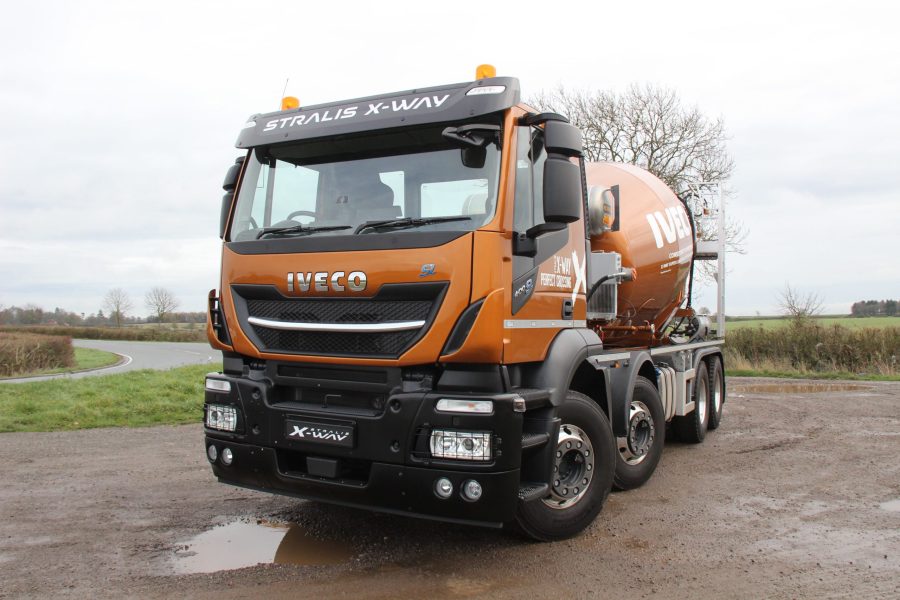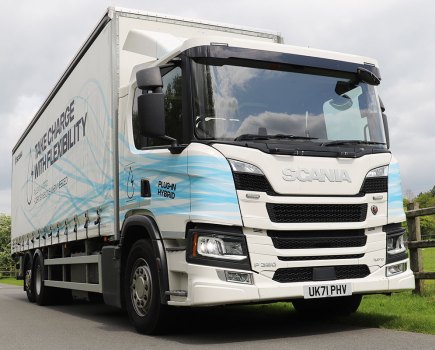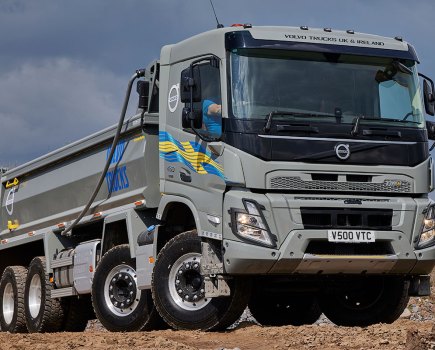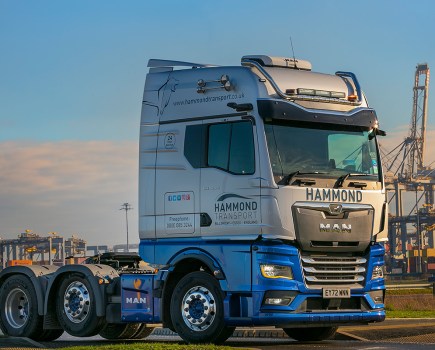Iveco is not the biggest player in the 8×4 construction market, but it has an impressive range of products and its new X-way might well be the best yet.
We writers in the specialist road transport press don’t get to road test eight-wheelers all that often, and those we do get our hands on tend to be tippers. So the opportunity to take an Iveco Trakker X-way 8×4 cement mixer out for an extended drive was too good to miss.
The 8×4 market – which is pretty much, but not exclusively the preserve of trucks for construction, plant and aggregate hauliers – has plenty of choice available to buyers. There’s a good mix of wheelbases, cabs, engines and chassis types. If you need maximum payload, there’s a chassis for that; if you need high power and a big cab, then manufacturers can deliver that for you.
Many manufacturers offer ‘standard’ chassis for typical day-to-day work which may involve a moderate degree of off-road driving, but recently there has been growth in the demand for beefed-up, stronger chassis for more ‘demanding’ muckaway and quarry work – the Scania XT, Volvo FMX and Mercedes-Benz Arocs being the most obvious examples in this sector.
Iveco has always produced a wide range of eight-wheelers, and like many products in the Italian manufacturer’s portfolio, they do not always get the recognition they deserve. The subject of this test is a perfect spec for a double-drive, twin-steer eight-legger. Under the cab is the 8.7-litre Cursor 9 six-cylinder engine producing 400 bhp in the 1655-2200 rpm band. The lump delivers 1700 Nm of torque between 1200-1655 rpm.
This Euro 6 engine uses SCR technology so avoids the need for AdBlue and has no active regeneration. It’s the most powerful version of the Cursor 9, which can also be specified at 310, 330 and 360 bhp outputs, but this highest-powered version is probably the best bet and the one most operators are likely to specify. If 400 bhp is not enough for you, and it might not be if you tow a drawbar trailer (some eight-wheelers do) or have lots of hilly terrain to contend with, then the 11.1-litre straight-six Cursor 11 is available at 420, 460 and 480 bhp outputs.
You can even specify the biggest engine, the Cursor 13 – a 12.9-litre lump in 510 and 570 bhp options, but perhaps we’d be diverging too far off the subject matter in hand with that one!
Our truck had the 12-speed Hi-Tronix automatic gearbox, but a manual ’box is also an option. Even on a cement mixer, it’s hard to look beyond an automatic gearbox these days.
The chassis can be 6.7 or 7.7 mm thickness, with the former usual for mixer applications. Our test truck had the 5020 mm wheelbase (other options are 4250, 4500, 4750, 5600 and 5820 mm), and was fitted with disc brakes front and rear. It also had parabolic suspension and a single reduction rear bogie.
Working quarters
Our test truck has the Active Day cab, which is perfect for weight-conscious operators whose drivers do not needs a night out. In the concrete mixer market this is quite often a vital tool to maximise payload. Personally, even if drivers are not doing any nights out, we prefer a single-bunk sleeper for a number of reasons; they have better resale, there’s more room for the driver’s stuff, there’s a bunk if a job or contract changes that does necessitate the occasional night out, and most importantly, it’s good to give the driver a chance to have a ‘power nap’ if (or more realistically, when) they are held up waiting to be unloaded or loaded.
Having said that, cement mixers don’t tend to hang around too much in between loads. But still, a driver has to have a 45-minute break each day, and why not let them have a bunk to take it on?
If you do want a sleeper cab, you can spec the Active Time (narrow) sleeper with a flat or high roof – the latter available as a twin bunk option. If you really want to give the driver the best cab available, the Active Space wider sleeper cab is the one to have, which is also available as a flat or high roof (the latter has the option of twin bunks). But this cab is probably not one for the vast majority cement mixer operators.
All cabs have three steps for access, while the sleeper cabs have the added bonus of external storage lockers useful for muddy boots, hard hats, gloves and hi-viz vests. All the stuff you don’t want in the cab making it dirty!
The truck we drove was the 400SL – SL stands for Super Loader, which means it’s the lightest chassis available. The unladen weight of the 8×4 is a remarkable 9450 kg thanks to alloy wheels, having a day cab and specifying the Cursor 9 engine. This can offer great payloads even once a mixer or tipper body is fitted. And remember, this is an 8×4 double-drive truck!
On the road
We collected the test, truck running on trade plates, in Spalding and the majority of our panned test route was single-carriageway secondary A and B roads. If you head east from Spalding, there are few if any hills, so we opted to head west and take in a circular route to Melton Mowbray via Bourne and Colsterworth, so we’d have plenty of hills to contend with – even if not necessarily the longest inclines. We are not talking the Scottish Highlands here.
However, the A151 road from Bourne to Colsterworth allows plenty of short inclines, including one at Grimsthorpe that comes straight after a pretty sharp right bend which can even slow cars down to as little as 25 mph. We were keen to see how the 400SL coped with this, and we have to say it did pretty well indeed – in fact, it didn’t drop below 25 mph. The rest of this A151 section has a lot for the driver to focus on, and the truck handled superbly well on this fairly challenging road.
Having passed Colsterworth, we continued along the B676. This is another road with plenty of twists and turns, sharp bends, short inclines and challenges for the driver and the truck. It’s roads like this that make you thankful for a responsive automated gearbox, and the X-way handled superbly on that score.
After negotiating Melton, we headed back towards Stamford, but avoided going into the picturesque – but not very truck-friendly – town itself. Instead, we joined the A1 southbound for a bit of dual-carriageway running down to Stibbington Diner, where it was time to pause for a brew.
Varied route
Refreshed, we returned to the A1, headed north briefly, before taking the A47 to Peterborough and the new(ish) road back to Spalding. The result was a healthy 100 miles or so and a good mix of varied roads. Ideally, we’d have liked to take it into a building site or a quarry, but getting permission for such driving is fraught with complications, and as this test was set up at relatively short notice it was easiest ‘not to go there’.
OK, we have to come clean here: sadly the truck was not loaded and the drum not rotating. So, my drive was based wholly on the unloaded experience, but nevertheless it was still a good barometer of the vehicle and how it performed. The length of drive was a typical run for a cement mixer; these trucks generally do not pound the tarmac for mile after mile. They tend to be used for short trips only.
The Hi-Tronix gearbox is lovely: it’s exceptionally smooth, with no lurching when it shifts through the gears. Hence pulling away is effortless and comfortable. The steering was precise and responsive. Rear vision via the large wing mirrors was excellent.
VERDICT
This Iveco is a serious player in the 8×4 rigid market, especially for weight-conscious operators. It’s light, handles like a dream and is easy – and enjoyable – to drive. The narrow day cab is compact, but there is still plenty of room for the driver to have his day-to-day equipment with them. But remember there are options for bigger (and sleeper) cabs if you need more space. The 400 bhp engine is perfect for this work, though again you can have more or less power if you want it – but the former will come with a weight penalty as it will require a bigger engine.
Ivecos are generally good on fuel, but this truck is aimed at a sector where fuel consumption is not the biggest criteria for a purchasing decision. Indeed, fuel saving is never going to be the best given the cement mixer body and the roads it will travel on.
A key driving factor will be price. The basic chassis cab price is a commendable £100,000. People like to diss Ivecos as poor quality, and we think that is not only a false accusation – or assumption – but one born out of ignorance rather than experience.
The Iveco is in a congested market and doesn’t look dated thanks to recent facelifts, which hide the fact the cab is 20-plus years old now. A new Iveco cab is expected “very soon”, even if the Turin manufacturer is a busy denying it – and is even a little touchy about pictures that have leaked onto the internet.
But that said, while the brand still has some work to do in terms of improving its acceptance, the fact remains most who try out Ivecos on construction work are generally pretty impressed. With that in mind, it’s worth casting your eyes over the X-Way because it can be a very attractive proposition indeed, both the product and the deals.
Specification
• Model: Iveco Trakker X-Way 8×4 mixer
• Design GVW: 36,000 kg
• Chassis: 5020 mm wheelbase
• Front & second axle: 8000 kg capacity each
• Rear drive axles: 9500 kg capacity each
• Gearbox: Hi-Tronix 12TX 1810 TD 12-speed automated manual
• Engine: Cursor 9, 8.71-litre, six-cylinder
• Max power: 400 bhp @ 2200 rpm
• Max torque: 1700 Nm @ 1200 rpm
• Cab: Active Day cab






